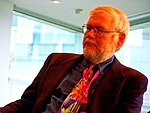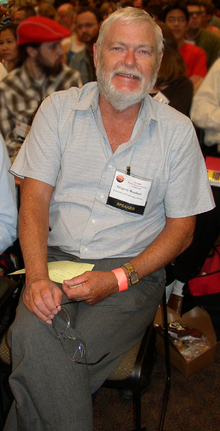Gregory Benford
Gregory Benford | |
|---|---|
 | |
| Born | January 30, 1941 Mobile, Alabama, U.S. |
| Occupation | Physicist, writer |
| Education | University of Oklahoma (BS) University of California, San Diego (MS), (PhD) |
| Genre | Science fiction, hard science fiction |
| Notable works | Galactic Center Saga novels |
| Spouse | Joan Abbe (died 2002) Elisabeth Brown |
| Children | 2 |
Gregory Benford (born January 30, 1941) is an American science fiction author and astrophysicist who is professor emeritus at the department of physics and astronomy at the University of California, Irvine. He is a contributing editor of Reason magazine.[1]
Benford wrote the Galactic Center Saga science fiction novels, beginning with In the Ocean of Night (1977).[2] The series postulates a galaxy in which sentient organic life is in constant warfare with sentient electromechanical life.
In 1969 he wrote "The Scarred Man",[3][4] the first story about a computer virus (based on a real computer virus he had spread[5]),[6] published in 1970.
Biography
[edit]Benford was born in Mobile, Alabama and grew up in Robertsdale and Fairhope.[7] Graduating Phi Beta Kappa, he received a Bachelor of Science in physics in 1963 from the University of Oklahoma in Norman, Oklahoma, followed by a Master of Science from the University of California, San Diego in 1965, and a doctorate there in 1967. That same year he married Joan Abbe, with whom he had two children.[8] Benford modeled characters in several of his novels after his wife, most prominently the heroine of Artifact. She died in 2002.[9]
Benford has an identical twin brother, James (Jim) Benford, with whom he has collaborated on science fiction stories.[10] Both got their start in science fiction fandom, with Gregory being a co-editor of the science fiction fanzine Void. Benford has said he is an atheist.[11]
He has been a long-time resident of Laguna Beach, California.[8]
Writing career
[edit]Gregory Benford's first professional sale was the story "Stand-In" in the Magazine of Fantasy and Science Fiction (June 1965), which won second prize in a short story contest based on a poem by Doris Pitkin Buck. In 1969, he began writing a science column for Amazing Stories.
Benford tends to write hard science fiction which incorporates the research he is doing as a practical scientist. He has worked on collaborations with authors William Rotsler, David Brin and Gordon Eklund. His time-travel novel Timescape (1980) won both the Nebula Award and the John W. Campbell Memorial Award. This scientific procedural novel eventually loaned its title to a line of science fiction published by Pocket Books. In the late 1990s, he wrote Foundation's Fear, one of an authorized sequel trilogy to Isaac Asimov's Foundation series. Other novels published in that period include several near-future science thrillers: Cosm (1998), The Martian Race (1999) and Eater (2000).[citation needed]
Benford has served as an editor of numerous alternate history anthologies, as well as collections of Hugo Award winners.
He has been nominated for four Hugo Awards (for two short stories and two novellas) and 13 Nebula Awards (in all categories). In addition to Timescape, he won the Nebula for the novelette "If the Stars Are Gods" (with Eklund).
Benford was a guest of honour at Aussiecon Three, the 1999 Worldcon. He remains[as of?] a regular contributor to science fiction fanzines, for example Apparatchik (defunct as of 1997).
In 2016 Benford was the recipient of the Los Angeles Science Fantasy Society Forry Award Lifetime Achievement Award in the Field of Science Fiction.[12]
Contributions to science and speculative science
[edit]
Gregory Benford is Professor Emeritus of Physics at the University of California, Irvine. With more than 200 scientific publications, his research encompassed both theory and experiments in the fields of astrophysics and plasma physics. His research has been supported by NSF, NASA, AFOSR, DOE and other agencies. He is an ongoing[when?] advisor to NASA, DARPA (Defense Advanced Research Projects Agency) and the CIA.
Benford's work in physics at the University of California focused on theoretical and experimental plasma physics, including studies of extremely strong turbulence, particularly in astrophysical contexts, and studies of magnetic structures from the Galactic Center to large-scale galactic jets. Working in collaboration with, among others, science fiction writers Cramer, Forward, and Landis, Benford worked on a theoretical study of the physics of wormholes, which pointed out that wormholes, if formed in the early universe, could still exist in the present day if they were wrapped in a negative-mass cosmic string.[13] Such wormholes could potentially be detected by gravitational lensing.
In 2004, Benford proposed that the harmful effects of global warming could be reduced by the construction of a rotating Fresnel lens 1,000 kilometres across, floating in space at the Lagrangian point L1. According to Benford, this lens would diffuse the light from the Sun and reduce the solar energy reaching the Earth by approximately 0.5% to 1%. He estimated that this would cost around US$10 billion. His plan has been commented on in a variety of forums.[14] A similar space sunshade was proposed in 1989 by J. T. Early,[15] and again in 1997 by Edward Teller, Lowell Wood, and Roderick Hyde.[16] In 2006, Benford pointed out one possible danger in this approach: if this lens were built and global warming were avoided, there would be less incentive to reduce greenhouse gases, and humans might continue to produce too much carbon dioxide until it caused some other environmental catastrophe, such as a chemical change in ocean water that could be disastrous to ocean life.[17]
Benford serves on the board of directors and the steering committee of the Mars Society.
He has advocated human cryopreservation, for example by signing an open letter to support research into cryonics,[18] being a member of Alcor,[19] and by being an advisor to a UK cryonics and cryopreservation advocacy group.[20]
Gregory Benford retired from the University of California in 2006 in order to found and develop Genescient Corporation. Genescient is a new generation biotechnology company that claims to combine evolutionary genomics with massive selective screening to analyze and exploit the genetics of model animal and human whole genomes.
Scientific awards and recognition
[edit]This section of a biography of a living person does not include any references or sources. (February 2019) |
- Phi Beta Kappa
- Woodrow Wilson Fellow
- Fellow of the American Physical Society
- Visiting Fellow
- 1995 Lord Prize for contributions to science
- 2006 Professor Emeritus at the University of California, Irvine
Benford's law of controversy
[edit]Benford's law of controversy is an adage from the 1980 novel Timescape:[21]
Passion is inversely proportional to the amount of real information available.[22][23]
The adage was quoted in an international drug policy article in a peer-reviewed social science journal.[24]
Selected bibliography
[edit]Galactic Center Saga
[edit]- In the Ocean of Night (1977)
- Across the Sea of Suns (1984)
- Great Sky River (1987)
- Tides of Light (1989)
- Furious Gulf (1994)
- Sailing Bright Eternity (1996)
- "A Hunger for the Infinite" a novella published in the 1999 anthology Far Horizons
References
[edit]- ^ Who's Getting Your Vote?, Reason
- ^ Witcover, Paul (2000-03-20). "Mean, stupid, ugly, and the terror of all other species". Sci Fi Weekly. Archived from the original on 2009-03-04. Retrieved 2008-08-06.
- ^ Benford, Gregory (2000). Worlds Vast and Various. New York: EOS. ISBN 9780380790548. OCLC 44128776., cited at "The Scarred Man Returns". Gregory Benford. Retrieved 13 Feb 2017.
- ^ Benford, Gregory (May 1970). "The Scarred Man". Venture Science Fiction. pp. 122–132. Republished on author's website at http://www.gregorybenford.com/extra/the-scarred-man-returns/ .
- ^ Afterthoughts, 1999
- ^ Easton, Thomas; Dial, Judith, eds. (July 8, 2010). Visions of Tomorrow: Science Fiction Predictions that Came True. Skyhorse Publishing. ISBN 978-1-60239-998-3.
- ^ Down the River Road — the Introduction | GREGORY BENFORD Retrieved 2011-11-16.
- ^ a b McLellan, Dennis (August 28, 1994). "The Science of Fiction : UCI Astrophysicist Gregory Benford Puts Reality Into His Novels". Los Angeles Times. Irvine. Retrieved 13 December 2015.
- ^ "Other Obituaries," Locus, May 2002, p.70
- ^ "ISFDB – James Bedford"
- ^ "Evil and Me", Benford; in 50 Voices of Disbelief: Why We Are Atheists
- ^ Publications, Locus (3 October 2016). "Locus Online News » Benford Wins Forry Award". www.locusmag.com. Retrieved 2016-10-03.
- ^ Cramer, J. G.; Forward, R. W.; Morris, M. S.; Visser, M.; Benford, G.; Landis, G. A. (1995). "Natural Wormholes as Gravitational Lenses". Physical Review D. 51 (6): 3117–3120. arXiv:astro-ph/9409051. Bibcode:1995PhRvD..51.3117C. doi:10.1103/PhysRevD.51.3117. PMID 10018782. S2CID 42837620. The press release Archived 2012-04-15 at the Wayback Machine on the paper can be found on Landis' website.
- ^ See Russell Dovey, "Supervillainy: Astroengineering Global Warming and Bill Christensen, "Reduce Global Warming by Blocking Sunlight" Archived 2009-04-17 at the Wayback Machine. Also see Solar radiation management§Dispersive solutions.
- ^ See footnote 23 in E. Teller, L. Wood, and R. Hyde, "Global Warming and Ice Ages: Prospects for Physics-Based Modulation of Global Change" Archived 2007-06-16 at the Wayback Machine.
- ^ E. Teller, L. Wood, and R. Hyde, "Global Warming and Ice Ages: Prospects for Physics-Based Modulation of Global Change" Archived 2007-06-16 at the Wayback Machine.
- ^ Comments at the 64th World Science Fiction Convention, August 2006.
- ^ "Scientists Open Letter on Cryonics". Archived from the original on 2016-08-26. Retrieved 2016-02-02.
- ^ "Alcor Member Profile: Gregory Benford". Retrieved 2016-02-02.
- ^ "UK Cryonics and Cryopreservation Research Network". Retrieved 2016-02-02.
- ^ Benford, Gregory (1992-08-01) [1980]. Timescape. Bantam Books. p. 182. ISBN 978-0-553-29709-6.
- ^ "EFF Quotes Collection 19.6". Electronic Frontier Foundation. 2001-04-09. Archived from the original on 2012-10-28.
- ^ "Quotations: Computer Laws". SysProg. Archived from the original on 2008-08-22. Retrieved 2007-03-10.
- ^ MacCoun, Robert J. (2001). "American distortion of Dutch drug statistics". Society. 38 (3): 23–26. doi:10.1007/BF02686215. S2CID 144452566.; official archival copy requires site registration. The article is a followup to pieces the author already published in Science (1997) and the Annual Review of Psychology (1998)
External links
[edit]- Gregory Benford official website Archived 2022-04-11 at the Wayback Machine
- Gregory Benford at the Internet Speculative Fiction Database
- Gregory Benford at IMDb
- Appearances on C-SPAN
- Giant rotating space lens, a possible engineering solution for global warming proposed by Benford in 2004
- "Terraforming Ganymede with Robert A. Heinlein" by Gregory Benford: part 1, part 2
- Homepage at UCI
- List of works at Fantastic Fiction
- "Killer Bs" (Brin, Benford, Bear, Baxter and B-, er, Vinge) mailing list
- 2012 Interview at Locus (magazine)
- The Gregory Benford Papers (74.25 linear feet) housed at the Eaton Collection of Science Fiction and Fantasy Archived 2018-02-02 at the Wayback Machine of the University of California, Riverside Libraries.
- 1941 births
- Living people
- 20th-century American male writers
- 20th-century American novelists
- 21st-century American male writers
- 21st-century American novelists
- 21st-century American physicists
- American astronomers
- American atheists
- American libertarians
- American male novelists
- American science fiction writers
- Analog Science Fiction and Fact people
- Cryonicists
- Fellows of Jesus College, Cambridge
- Fellows of the American Physical Society
- Life extensionists
- The Magazine of Fantasy & Science Fiction people
- Mars Society
- Nebula Award winners
- Novelists from Alabama
- People from Fairhope, Alabama
- People from Laguna Beach, California
- People from Orange County, California
- People from Robertsdale, Alabama
- Science fiction critics
- University of California, Irvine faculty
- University of California, San Diego alumni
- Writers from Mobile, Alabama
